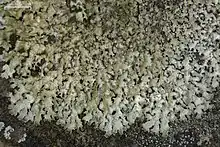Parmelia fraudans
Parmelia fraudans is a species of foliose lichen in the family Parmeliaceae. It is found in Europe and North America, where it grows on rocks.
| Parmelia fraudans | |
|---|---|
 | |
| in Wells Gray region, British Columbia, Canada | |
| Scientific classification | |
| Domain: | Eukaryota |
| Kingdom: | Fungi |
| Division: | Ascomycota |
| Class: | Lecanoromycetes |
| Order: | Lecanorales |
| Family: | Parmeliaceae |
| Genus: | Parmelia |
| Species: | P. fraudans |
| Binomial name | |
| Parmelia fraudans (Nyl.) Nyl. (1869) | |
| Synonyms[1] | |
| |
Taxonomy
The lichen was originally named as a subspecies of Parmelia saxatilis by William Nylander in 1861. He noted its occurrence on rocks among mosses in North Savo as well as in Kajaani.[2] Nylander promoted it to species status in 1869.[3]
Molecular phylogenetic analysis shows that Parmelia fraudans is a member of the Parmelia sulcata species group, and it is estimated to have begun diversification during the Pliocene, about 3.3 million years ago.[4]
Description
The foliose (leafy) thallus of Parmelia fraudans is tightly attached to its substrate, typically measuring 4–16 cm (1.6–6.3 in) in diameter. The brittle, flat lobes that comprise the thallus range from contiguous to overlapping, and are 1–4 mm wide, with truncated tips. The colour of the upper thallus surface is grey to yellowish grey, while texturally it is smooth to delicately pitted, with pseudocyphellae and soredia. The soredia, which somewhat resemble isidia, are abundant and are concentrated along the margins of the thallus. The medulla is white. The thallus undersurface is black in the centre, becoming brown towards the margins. Numerous black rhizines (both branched and unbranched) act as holdfasts. Apothecia are rarely observed; when present, they measure 2–4 mm in diameter and have a dark brown disc, with soredia typically on the apothecial margin. The ascospores have an ellipsoid shape and measure 10–12 by 5–6 μm.[5]
The expected results of standard chemical spot tests on Parmelia fraudans are cortex K+ (yellow), C−, KC−, P+ (yellow); medulla K+ (yellow becoming deep red), C−, KC−, and P+ (orange). Secondary compounds found in the lichen are atranorin and chloroatranorin in the cortex (and sometimes usnic acid in the soralia), and salazinic acid as a major component of the medulla, with minor amounts of consalazinic acid and protolichesterinic acid. The yellowish tone of the soralia caused by usnic acid is unique in the genus Parmelia.[5]
Habitat and distribution
Parmelia fraudans occurs in Europe and North America, where it grows on rocks. Its North American distribution extends from Alaska[6] south to Mexico.[5] Although it is generally rare in Eastern Canada, it was reported as new to Nova Scotia in 2022.[7] In Europe, it has been recorded from the Czech Republic, Estonia, France, Finland, Greenland, Norway, Russia, Sweden, and Slovakia.[8] In the 2019 red list of Estonian lichens, it was classified as a critically endangered species due to a reduction of its range and a decrease in population size (compared to its 2008 assessment).[9]
References
- "Record Details: Parmelia fraudans (Nyl.) Nyl., Flora, Regensburg 59(19): 292 (1869)". Index Fungorum. Retrieved 2 January 2022.
- Nylander, W. (1861). "Lichenes Scandinaviae sive prodromus lichenographiae Scandinaviae". Notiser ur Sällskapets pro Fauna et Flora Fennica Förhandlingar (in Latin). 5: 100.
- Nylander, W. (1869). "Circa reactiones Parmeliarum adnotationes". Flora oder Botanische Zeitung (in Latin). 52: 292.
- Molina, M. Carmen; Divakar, Pradeep K.; Goward, Trevor; Millanes, Ana M.; Lumbsch, H. Thorsten; Crespo, Ana (2016). "Neogene diversification in the temperate lichen-forming fungal genus Parmelia (Parmeliaceae, Ascomycota)". Systematics and Biodiversity. 15 (2): 166–181. doi:10.1080/14772000.2016.1226977. S2CID 88996791.
- Nash III, Thomas H. (2016). "Parmelia in Mexico". In Herrera-Campos, Maria; Pérez-Pérez, Rosa Emilia; Nash, Thomas H. III (eds.). Lichens of Mexico. The Parmeliaceae – Keys, distribution and specimen descriptions. Bibliotheca Lichenologica. Vol. 110. Stuttgart: J. Cramer. pp. 309–312. ISBN 978-3-443-58089-6.
- McCune, B (2018). "Biodiversity and ecology of lichens of Katmai and Lake Clark National Parks and Preserves, Alaska". Mycosphere. 9 (4): 859–930. doi:10.5943/mycosphere/9/4/10.
- Anderson, Frances; Bouchard, Mathieu; Boudreault, Catherine; McCarthy, John; Hanel, Claudia (2022). "Noteworthy range extensions of two lichens in Eastern Canada: Erioderma pedicellatum (Pannariaceae) new to Québec and Parmelia fraudans (Parmeliaceae) new to Nova Scotia". Evansia. 39 (1): 20–28. doi:10.1639/0747-9859-39.1.20.
- Hawksworth, David L.; Blanco, Oscar; Divakar, Pradeep K.; Ahti, Teuvo; Crespo, Ana (2008). "A first checklist of parmelioid and similar lichens in Europe and some adjacent territories, adopting revised generic circumscriptions and with indications of species distributions". The Lichenologist. 40 (1): 1–21. doi:10.1017/S0024282908007329. S2CID 84927575.
- Lõhmus, Piret; Marmor, Liis; Jüriado, Inga; Suija, Ave; Oja, Ede; Degtjarenko, Polina; Randlane, Tiina (2019). "Red List of Estonian lichens: revision in 2019". Folia Cryptogamica Estonica. 56: 63–76. doi:10.12697/fce.2019.56.07. S2CID 210301439.